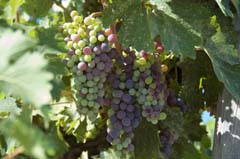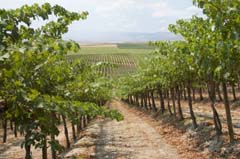Basics of Growing Wine Grapes
By Kori ~ September 3rd, 2008.
 Growing wine grapes is not an uppity business; it is basic agriculture (see my post from June 16). And most growers are salt-of-the-earth folks.
Growing wine grapes is not an uppity business; it is basic agriculture (see my post from June 16). And most growers are salt-of-the-earth folks.
A wine grape consists of about 71-85 percent water, on average about 13-27 percent sugar (which is converted into alcohol during the fermentation process), and about 2 percent skin, pips and everything else. If a winemaker knows how much alcohol he wants in his wine, he can pick the grapes when they have developed the right amount of sugar.
Wine grapes need and love sunshine but not too much sunshine. Just like other fruit, not enough sunshine and the grapes won’t ripen, too much sunshine and they’ll burn. In a perfect world, you’d have a vineyard with long, hot sunny days and cool, breezy nights.
Grapevines also need water to survive but too much water is bad, too. A wine growing area like Washington State that can provide controlled irrigation to its vineyards has a big advantage over those totally dependent on nature.
Wine grapes generally do best in “bad†soil on a hillside, facing towards the equator (south in the northern hemisphere). They can make otherwise barren land productive. The average person probably does not realize how productive grapevines can be. As Lynn Hoffman says in The New Short Course in Wine:
“Even old vines severely pruned to concentrate their juice will produce over a thousand full-sized bottles per acre. Irrigation and lenient pruning can multiply that figure ten-fold….There is no crop that yields as great a value per acre of ground as wine grapes.â€
 Once grapes are picked, they are processed into wine. Yeasts that grow on all grape skins automatically ferment grape juice into wine when the grapes are crushed, although many wineries today add their own yeast to jump-start the process.
Once grapes are picked, they are processed into wine. Yeasts that grow on all grape skins automatically ferment grape juice into wine when the grapes are crushed, although many wineries today add their own yeast to jump-start the process.
The skins of all wine grapes are basically red in color, but the juice is naturally clear. Therefore, the way to make white wine is to separate the juice from the skins almost immediately so that the wine extracts none of the skin’s red color pigment. To produce a red wine, winemakers let the fermentation run its full course in contact with the skins. The longer the skin contact, the greater the extraction of red color and the greater the intensity of the wine because the skins are also where the tannins are found.
While winemakers get most of the attention in the wine business and do make the decisions on when to harvest, how to blend, how long to keep the wine in barrels, and when to bottle, the best winemakers will freely admit that it is really the grape grower who is primarily responsible for the quality of the wines that they produce. If the quality of the grapes is not present, there is only so much a winemaker can do.
Filed under: General Wine Information, Vineyards

 Wine Peeps is an independent wine blog dedicated to helping you get the most bang for your buck in wine. We do this through blind tastings of wine from around the world and calculations of
Wine Peeps is an independent wine blog dedicated to helping you get the most bang for your buck in wine. We do this through blind tastings of wine from around the world and calculations of 











Hi Kori!
I just wanted to comment on your statement:
“A wine grape consists of about 85 percent water, on average about 13 percent sugar (which is converted into alcohol during the fermentation process), and about 2 percent skin, pips and everything else.”
A quick look at one of my winemaking textbooks says that grape juice consists of
* 75-85% water
* 17-25% sugar
* 0.4-1% organic acids
* 0.3-1% everything else
And that grapes at crush consist of:
* 60-70% pulp (including water)
* 20-30% skins
* 0-5% seeds
* 2-6% stems
Besides, if grapes were 13% sugar, when fermented that would add up to barely 6% alcohol by volume.
Just sayin’. Now off to give my girls their bath before bedtime! Cheers!
Randy,
Thank you for the catch. I was trying to keep it simple but should have given a range. My original numbers were for a low alcohol white but I’ve amended the post to make it more accurate. Cheers!
An excellent site about how to grow grapes and make wine